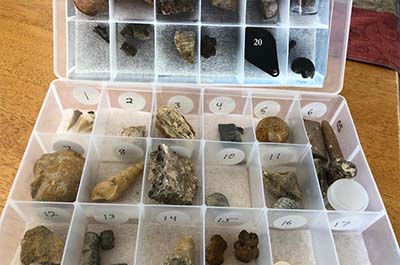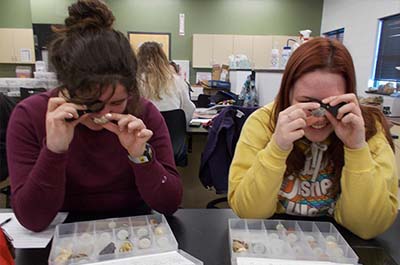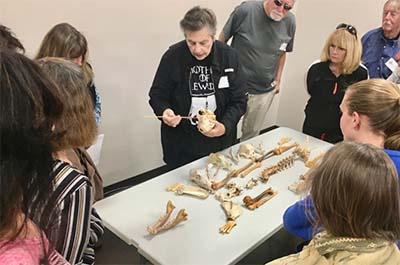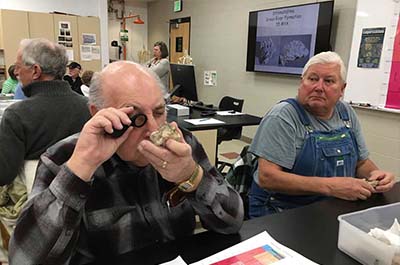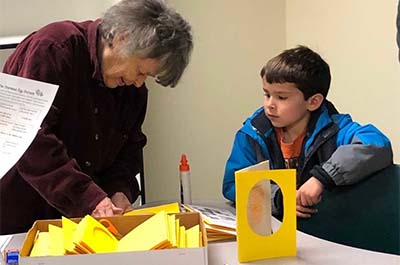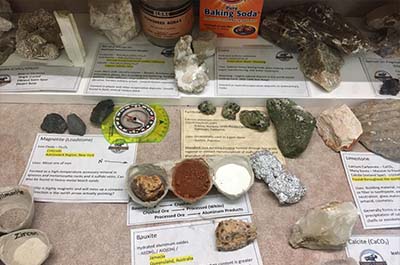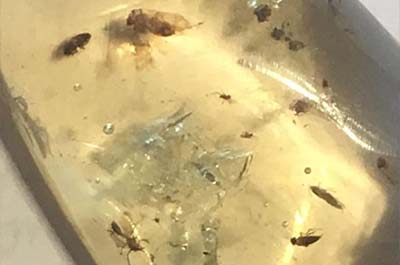Fossil Boot Camp at PCC Mini-College
by Cindy Smith
For the 5th straight year, Stones ‘n Bones presented Fossil Boot Camp to 31 senior citizens in the Fremont County community. Due to the popularity of the class and the high amount of material to introduce, we presented a full day class for the first time, giving participants plenty of time to become familiar with common fossils such as ammonites, baculites, trilobites, gastropods (snails), fish scales from Fremont County, and many other fossils.
Community members study the detail in stromatolites, algal mats that provided the first oxygen to Earth’s atmosphere.
This year Andrew Smith, BLM paleontologist with the Royal Gorge Field Office in Cañon City, joined us. Andrew started off the morning with an understandable explanation of a very complex subject – Deep Time. He explained the beginning of Earth’s history 4.6 billion years ago, the major extinction events, and various milestones in life along the way, e.g. the transition from a toxic (to humans) atmosphere into one incorporating oxygen given off by the first photosynthesis from algal mats called stromatolites, marine animals making their way onto land, the evolution of plants and pollinators, and the first primates. He explained the delicate process involved in the preservation of fossils, the rare preservation of soft-bodied fossils, and the regulations for responsible collecting of fossils.
Harold Taylor, retired professor of statistics at the Colorado School of Mines, then provided detailed information about the many common fossils that can be found locally, including the environment they lived in, when they lived, their anatomy, the niche they occupied in the food chain, and the information scientists today can retrieve from the study of paleontology.
Loretta Bailey has done extensive collecting in the Pierre Shale in the Cañon City embayment.
A new addition to our presentation was the study of dinosaur footprints and the information embedded in their spacing. Using simple formulas, students measured their stride and pace, and then determined their speed, which indicated whether they were walking, trotting or running.
From end-of-class participant comments and evaluation forms, it was evident that stromatolites, ammonites, and trilobites were the most interesting to the majority of students. We thoroughly enjoy introducing the joy of fossils to our community, and we readily observe the stimulation and interest this sparks in people of all ages.
More Articles from “Stones n’ Bones Activities”
Fossil Boot Camp – Covid Style
Stones ‘n Bones of Fremont County traditionally presents two or three Fossil Boot Camp classes each year for school age students and adults. With COVID, that has proven a little difficult
Fossil Boot Camp for PCC Historical Geology Students
Fremont Stones ‘n Bones introduced 16 Pueblo Community College students to fossils in Steve Wolfe’s Historical Geology class.
Stones ‘n’ Bones With Villa Bella School’s 2nd Graders
“What do paleontologists do?” is the question we were asked to help answer for 50 second graders at Pueblo, Colorado’s newest elementary school on January 16, 2020.
The Close Relationship Between Man & Dog
Dr. Sue Ware returned to the Royal Gorge Dinosaur Experience for the second time, to the delight of 27 community members. She presented a program entitled “From your Campfire to your Bed: The Evolution, Importance & Relationship between Dogs and Humans”.
Fossil Boot Camp at PCC Mini-College
For the 5th straight year, Stones ‘n Bones presented Fossil Boot Camp to 31 senior citizens in the Fremont County community.
Stones ‘n’ Bones & the Enormous Egg
What happens when an entire elementary school reads the same book, The Enormous Egg, and asks Fremont County Stones and Bones to come in to help with the family night to celebrate the reading? A two-hour evening full of paleontology learning!
Introducing Geology Students to Fossils
How does Steve Wolfe, Historical Geology instructor at PCC-Fremont Campus, prepare his students for field season observations? One way is by introducing them to fossils
Identifying Trilobites
The Pioche Formation of eastern Nevada is world famous for its amazing preservation of trilobites. Very old trilobites, from the Lower Cambrian (542 – 521 million years old), almost the oldest on record.
Everything Begins With Mining
There are many ways to appreciate rocks. Many of us notice them simply for their color, texture and shape, irresistible and raw in nature.
Insects Trapped in Amber
Many of us are familiar with the high preservation of insects and leaves in the Green River Formation, a Colorado lagerstätte well known for field trips yielding magnificent fossils.

